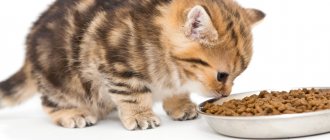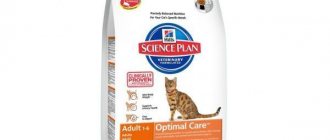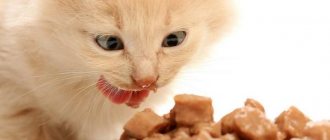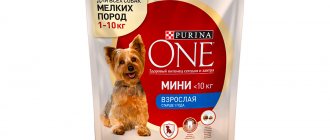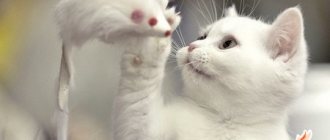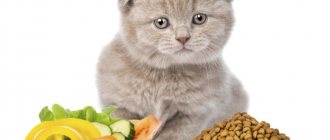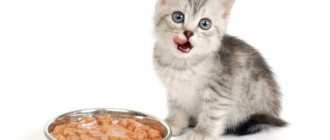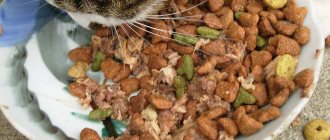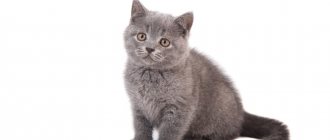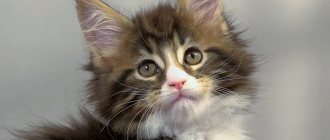With the arrival of a new pet in the apartment, a significant list of worries and troubles arises for a person. Cats cannot say what worries them or what they want; owners begin to understand without words only over time. If everything is quite simple with litter box training, buying toys and scratching posts also does not create big problems, then choosing the right and nutritious diet can confuse even knowledgeable breeders.
Kittens at the age of two months feed on their own, but their stomach has not yet fully adapted to the adult diet. A growing body requires a lot of vitamins and nutrients in order to eventually grow into an active, healthy cat with shiny and silky fur.
First, you need to decide on the type of food you choose. This can be natural food, ready-made specialized food or a mixed feeding method. There are many conflicting opinions about the last option, even among veterinarians. Therefore, most often they choose a diet based on their financial capabilities and the availability of free time for cooking.
You might be interested in:
- What to feed a one-month-old kitten
- What to feed a half year old kitten
Choosing a diet for a 2 month old kitten
To choose the optimal diet, it is necessary to take into account the interests of the parties. You should pay attention to the kitten’s gastronomic preferences, as well as evaluate your capabilities, mainly financial and availability of free time.
There are three types of food:
- Natural food.
- Ready-made industrial feed.
- Mixed nutrition.
Each of these types has its pros and cons. To understand whether the chosen food is suitable for a kitten or not, you need to pay attention to three simple indicators:
- Daily formed stool.
- Shiny healthy coat.
- The animal does not refuse food and eats with appetite.
Natural nutrition
There is a misconception that feeding a kitten natural products means sharing what we eat (soups, salads, cutlets, sausage, sausages, etc.) This is far from true. Natural nutrition is a diet consisting of a set of healthy and necessary ingredients. You need to feed your kitten a diet balanced in proteins, fats and carbohydrates.
For example, proteins are found in meat, fish, and eggs. Fats are found in egg yolks, butter, and offal. Animals get carbohydrates from cereals (buckwheat, rice, oatmeal and others).
Benefits of natural nutrition
- The owner has the opportunity to choose the products himself and be confident in their quality.
- The ability to always feed your pet fresh food.
- Products can be replaced, thereby obtaining a varied diet without harming the body.
- No addiction.
Disadvantages of natural nutrition
- You need to know how to properly prepare food so that it is as healthy as possible.
- You need to know the list of prohibited products.
- It spoils quickly.
- Additional vitamins and minerals are often required.
Recommended Products
What to feed a 2 month old kitten using natural products? The diet should be based on proteins, and this is meat. For kittens at 2 months old, types of meat such as beef and poultry (turkey, chicken) are good.
Meat alone will not be enough; it is best to mix it with cereals (buckwheat, rice, oatmeal). The porridge should be homogeneous, it is better to grind the meat finely. In this case, the kitten will not be able to choose only tidbits from the bowl. This way the food will be absorbed better. At 2 months, the kitten is still unable to chop food well, you need to remember this.
Dairy products are also necessary in the diet. This can be low-fat cottage cheese, yogurt without additives.
Fresh or boiled vegetables and fruits will also be beneficial. You can only feed green ones (no grapes and avocados), since red and yellow ones can cause allergies (carrots and pumpkin are exceptions).
Fats must be given. You can add vegetable or butter to your food in a small amount (½ teaspoon) 1-2 times a week.
There are foods that are useful to feed a kitten, but they should be given in limited quantities: sea fish, liver, whole milk, chicken yolk (half). They should be given once a week. More frequent consumption of these products may lead to negative consequences.
Vitamin and mineral supplements should also be included in the diet.
Feeding with natural products
At two months the kitten switches to rough food. Therefore, the diet becomes varied. For both people and animals, it is necessary to follow a complete and balanced menu. When introducing a new ingredient, you should pay attention to the reaction of the animal’s body. Each pet is unique, so allergies or inability to digest one or another component of the menu are possible.
At the first suspicious symptoms (weakness or lethargy of the kitten, vomiting, fur began to fall out suddenly), it is better to contact a veterinarian to avoid unpleasant consequences.
The benefits of choosing natural food for kittens are obvious.
Firstly , fresh products are selected. The chances of unnecessary chemicals or harmful substances entering the body are minimized, which means the food will be safe.
Feeding a kitten at six months
Feeding 3 month old kittens
Feeding a kitten at the age of 2 months
Secondly , diet diversity. Pamper your pet with something new every time.
Thirdly , such a food choice will not cause painful addiction, that is, there will be no development of addiction. You can safely replace foods with one another without causing stress to the kitten’s stomach.
Where there are pros, you can always find cons.
The disadvantages of this diet include the following:
- It is quite difficult to balance the food. The required amount of vitamins, minerals and trace elements for a growing body is required in large quantities. Therefore, for auxiliary nutrition, the missing supplements are purchased and added to the menu.
- Carefully monitor the quality of products to ensure that they do not contain anything dangerous or harmful to your pet’s digestive system.
Healthy eating from natural ingredients
Each new product should be introduced one at a time, gradually expanding and complicating the possible menu. The acceptable and safest foods for a kitten's diet are listed in the table.
| Products | Why are they useful? | In what form are they included in the diet? | Feeding frequency |
| Lean meat, for example: turkey or chicken, beef, rabbit. An alternative option would be canned children's meat that has already undergone the necessary processing for consumption. | Proteins of animal origin, so necessary for the growth and proper formation of a growing organism | Meat is added to the menu exclusively in boiled form, and for kittens it must be mechanically processed in a blender to the state of puree or small pieces. The skin is removed from poultry meat, since this is still too heavy food for the kitten’s developing body. | 4 times a week - 60-70% of the daily diet |
| Beef or chicken liver | Iron | It is given in the menu in boiled form | 1-2 times a week |
| By-products: heart, brains | Provide phosphorus | It is given in the menu in boiled form | 1-2 times a week |
| Chicken eggs | Protein for shiny and strong coat. Squirrels | Only the yolks of boiled eggs. Proteins are not digested | 1 time per week |
| Quail eggs | Boiled. Fresh ones are added to porridge | ||
| Porridge: rice, oatmeal, millet or buckwheat | Carbohydrates. Fiber for good digestion | Cooked in milk, vegetable or meat broth | 2 times per week |
| Low-fat sea fish | Phosphorus | Added to the diet boiled and deboned. | 1-2 times a week |
| Cottage cheese | Source of calcium for tooth growth, bone development | Mixed with low-fat sour cream | 1 time per week |
| Dairy products: milk, natural yogurt, fermented baked milk, kefir. Children's dairy products are used as an alternative | Does not replace water, give at room temperature | ||
| Cheese | For kittens it is used as a treat in small pieces | 1-3 times a week | |
| Fresh, raw or cooked vegetables: carrots, cucumbers, asparagus, beans, lettuce, zucchini, broccoli, celery | A storehouse of vitamins, microelements, fiber | Served separately or boiled. You can prepare assorted vegetable puree | 10% daily value |
| Fruits: melon, watermelon, apples, pear | Sources of vitamins and minerals | Used as a treat | 2-3 times a week |
| Sprouted oats or wheat | Vitamins, folic acid, microelements. Normalizes digestion | The container with sprouted grass is placed in a place accessible to the kitten, where it can be chewed at any convenient time. A bunch of grass is finely chopped with scissors for food. | 2-4 times a week |
| Vaseline oil | Normalization of digestion | Poured from a spoon or pipette into the pet's mouth | 2 times a week, half a teaspoon |
Diet preparation for kittens
A kitten's small stomach is ready to accommodate large amounts of food. At a young age, the kitten is not yet able to control its appetite. To avoid further problems, for example, not to stretch the stomach, it is recommended to divide the daily intake into five to six meals. A two-month-old cat eats 150-200 grams of food per kilogram of its own weight per day. Depending on the kitten’s health, the veterinarian will select the appropriate food.
A rational option would be to create a menu for the week. Then you get rid of the daily question: what to cook today. List the required ingredients by day of the week, adding missing vitamin supplements daily. Food is given at room temperature, uneaten leftovers are stored in the refrigerator until the next meal, but only for 24 hours. It is important to ensure that the kitten always has fresh water, preferably bottled, without unnecessary impurities.
What not to feed at two months
Wholesome and healthy food is the right choice for your beloved pet. But among the products it is worth highlighting some that cannot be given to a kitten for a number of reasons.
| Prohibited Products | Cause |
| Raw freshwater fish | Risk of helminth infection |
| Fatty dairy products | Disturbance of intestinal flora, obesity, digestive problems |
| Fatty meats, such as pork | |
| Smoked products: sausages, meat, lard | Excessive salt and fat content leads to stomach problems |
| Home and store preserves | Vinegar, salt, seasonings included in the composition will cause irreparable damage to digestion |
| Bones | The sharp ends of the bones scratch the larynx and esophagus, which leads to undesirable consequences |
| Whole milk | Cats lack the enzyme that breaks down whole milk. The product is not digestible by the stomach |
| Chocolate | Contains harmful substances that negatively affect the nervous system and heart. Consumption can lead to dehydration and even death. |
| Potato | Not digestible by the cat's body |
| Some vegetables and fruits: avocado, eggplant, onion, garlic, tomatoes | Toxic to animals |
| Sweets, flour products | Harmful due to sugar and yeast content |
| Salt, sugar, seasonings | Benefits - zero, only harm to health: caries, obesity, allergic reactions |
Summary
The diet of a two-month-old pet is not much different from the food of a child up to one year old. Choosing fresh food for your pet shows care and attention to the cat’s health. If you are ready to devote a sufficient amount of time to cooking, do not forget to add the necessary vitamins, and monitor proper nutrition, then a grateful cat will grow up healthy and full of vitality.
What should you not feed?
There are a number of foods that must be excluded from a kitten’s diet from 2 months and for life.
The following foods should not be fed:
- Food from your table.
- Raw meat.
- River fish.
- Waste (chicken heads, paws, necks, bones, fish spines).
- Egg white.
- Fatty meats (pork, lamb).
- Salted, fried, spicy, smoked, peppered.
- Canned food.
- Foods that cause bloating (legumes, cabbage).
- Some fruits (grapes, avocados, citrus fruits).
- Vegetables of the nightshade family (tomatoes, eggplants, potatoes).
- Onion and garlic.
- Sweets (cookies, chocolate, etc.).
Consumption of these products can lead to serious consequences, and in some cases, death.
Ready-made industrial feeds
This food is already ready to eat. Their composition is already balanced in proteins, fats and carbohydrates. Also, the composition already contains vitamins and micro- and macroelements necessary for a growing body. There are two types of prepared food: dry and wet. It is better to feed one type. If you decide to combine, then do not give a dry and wet look at the same time.
Advantages of ready-made feeds
- The food is now ready to eat. No additional cooking time required.
- The composition is already balanced. All that remains is to determine the norm on the packaging, focusing on weight and age.
- Eating dry food provides the kitten with a moderate load on the jaws, which contributes to their proper development.
- It is possible to select a special diet based on your physiological state.
Disadvantages of ready-made feeds
- Price. It is believed that a quality product is expensive.
- Difficulty choosing among numerous brands.
- Certain storage conditions are required. The feed should not sit stale. Fats deteriorate when exposed to air and significantly reduce the quality and freshness of food.
- Economy class food contains many unnecessary substances, flavor enhancers, artificial flavors and preservatives. The animal becomes dependent on these components.
Veterinarian recommendations
When it comes to choosing what food to feed a 2-month-old kitten, many owners are faced with a huge variety of diets. At first glance, they are no different from each other except packaging and price. In such a situation, you should take the advice of a veterinarian.
All feeds are divided into 4 classes:
- Economy class (Felix, Friskies, Purina One, Sheba, Whiskas, Nasha)
- Premium class (Probalance, Pro Plan, Sirius, Royal Canin, Schesir, Happy Cat, Eukanuba)
- Super premium class (Monge, Savarra, Sanabelle, Pronature Original, 1st Choice)
- Holistics (Grandorf, Naturea, Go Natural, Farmina N&D, Pronature Holistic)
Holists are considered the best. Their composition contains mainly animal protein, namely fresh meat. If it is not possible to feed your pet holistically, then veterinarians advise giving preference to super premium or premium food.
The norm must be strictly followed. The norms are indicated on the packaging and are selected based on the weight and age of the kitten.
You need to feed food appropriate to the type of animal, its age and physiological condition.
Transfer from one manufacturer to another should be carried out gradually so as not to cause gastrointestinal disorders.
When feeding dry food, the animal should always have free access to water.
Food should not sit in a bowl all day. The fats included in the composition burn out in the air and such food can be considered of low quality.
Happy Cat Supreme Kitten
Belongs to the premium class. Designed for feeding kittens from 5 weeks to 6 months. The size and shape of the kibble are adapted to the kitten’s physiology.
The source of animal protein is poultry (29%), meat products, salmon (3.5%) and dried eggs. The composition contains a number of useful additives, such as: prebiotics, dandelion, ginger, chamomile and others. But it also contains an undesirable ingredient - cellulose.
Nutrition recommendations at 2 months: 40 grams (medium breeds) and 55 grams (large breeds).
1st Choice
Belongs to the super premium class. Suitable for feeding kittens from 2 months to one year. Convenient size of granules, which allows the kitten to easily eat this food.
The source of animal protein is fresh chicken (17%), poultry meat and flour (17%). The composition also contains the following useful ingredients: flax seed, brown rice, fish oil, a full range of vitamins and minerals. There are some harmful ingredients; it contains cellulose.
It is recommended to feed kittens at 2 months: 20-40 grams (medium breeds) and 40-75 grams (large breeds).
Purina ProPlan Junior
Belongs to the premium class. Recommended for kittens from 1.5 months to one year.
The diet is quite balanced and contains natural meat. The composition is enriched with prebiotics. There is a line for kittens with sensitive digestion. Protein content 15-17%. Also contains vegetable protein, soy, corn and preservatives. In addition to natural meat, processed products are used, thereby reducing the quality of the feed. They come in three types: dry, wet and mousse.
Recommendations for nutrition of kittens at 1.5 - 3 months - 20-70 grams.
Monge kitten
Belongs to the super premium class. Suitable for kittens from 1 month to one year.
The composition contains a large amount of protein, namely chicken (dehydrated 26%, fresh 10%). The composition is rich in vitamins and minerals. Contains natural flavors and preservatives. The line for kittens includes a version with trout, where the content of dehydrated trout is 30%
Nutritional recommendations for a kitten aged 2 months – 45 grams.
Cat milk replacer “Royal Canin Babycat Milk” (for kittens from 0 to 2 months)
A mother's milk replacer developed for newborn kittens. For up to 2 months, the mixture must be given to cover the need for nutrients. The need to feed offspring with this composition arises due to the large number of cubs in the litter. The mother's body cannot produce enough milk.
"Royal Canin Babycat Milk" corresponds to the peculiarities of the digestive system of a newborn kitten. After birth, the baby's body does not accept milk sugar (lactose) well. Kitten food in the form of cow's milk is strictly contraindicated for babies over 1 month of age. The mixture is nutritious and high in calories, thanks to which all the most important systems and organs develop in accordance with age.
Milk replacer promotes rapid growth of kittens (minimum 10 grams per day). The pack contains 3 bagged packages, nipples of three diameters, as well as a bottle with division and a measuring spoon. Thanks to the exact instructions, you will be able to measure the required dosage and prepare instant milk correctly.
Mixed nutrition
Mixed nutrition is a combination of natural products and ready-made feed.
Advantages of mixed nutrition:
- You can feed your kitten a varied diet.
Disadvantage of mixed nutrition:
- High risk of imbalance in proteins, fats and carbohydrates. As a consequence, metabolic disorders lead to the development of various diseases.
Opinions about the correctness of a mixed type of diet vary. There are supporters of mixed nutrition who believe that a kitten on such a diet receives everything it needs. And there are those who are against such a diet, arguing that an imbalance occurs in the body, and this entails metabolic disorders. Also, a mixed diet can cause digestive disorders.
It is recommended to decide what to feed the kitten at 2 months and stick to this diet in the future.
General nutrition rules
- You need to feed your kitten only fresh food from good quality products.
- Storage of natural food and wet prepared food is carried out in the refrigerator. Ready-made dry food is stored in a closed container without access to oxygen. The storage periods and conditions indicated on the packaging should be observed. With natural nutrition, the shelf life of food is no more than 24 hours; wet prepared food is stored for no more than two days after opening the package.
- The daily dose should be given in several doses.
- It is better to feed warm food or at room temperature.
- Your pet should have free access to fresh water.
- The dishes from which the kitten eats and drinks must be clean.
- Do not allow food to sit in the bowl. If the kitten does not eat the portion immediately, it should be put in the refrigerator to avoid spoilage.
- When eating natural foods, be sure to add vitamin and mineral supplements to your food.
The best wet food for kittens from 1 month
Wet food, designed for kittens from 1 month of age, contains a large amount of liquid. It is easier to digest and does not require soaking.
No. 1. Mealfeel Functional Nutrition Junior, wet food for kittens with lamb
Balanced food consists of pieces in sauce. The composition contains more than 40% meat components. Important nutrients, minerals and vitamins are also present. All this is necessary for the full development and growth of the animal.
The product contains taurine, which preserves the integrity of nerve tissue, strengthens vision and the immune system. The food is produced under the control of the European Union at the largest factories in Belgium and France. The daily intake is indicated on the packaging. The serving size depends on the physical condition and activity of the pet.
No. 2. Purina Pro Plan Nutrisavour Junior, wet food for kittens with chicken
All wet kitten food is manufactured under strict guidelines. It's hard to say which is better. Purina Pro Plan Nutrisavour Junior contains all the necessary components for the full development of your pet.
The food contains a lot of meat and fish by-products, meat, fiber, ash, vitamins, and mineral compounds. Kittens 4-12 weeks old need 2-5 sachets per day. The amount of food is determined by the activity of the animal.
